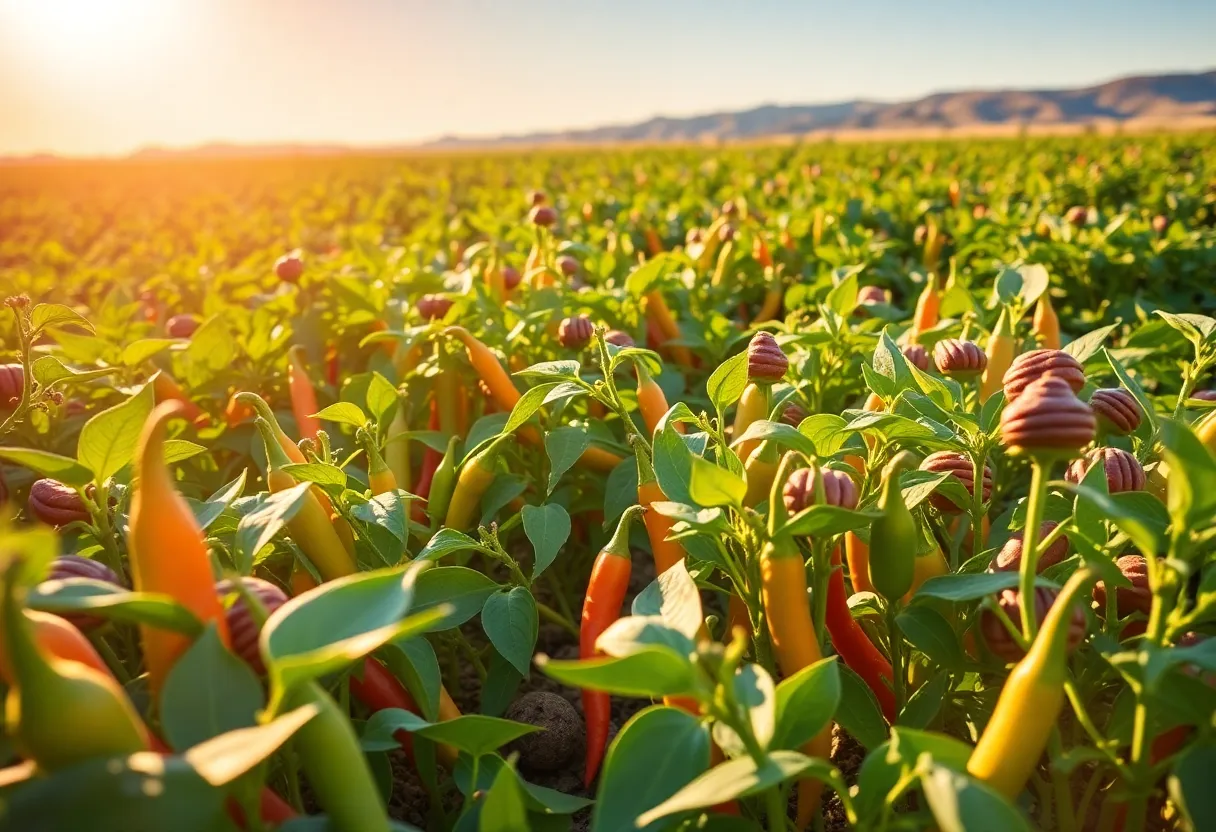Albuquerque, October 27, 2025
New Mexico’s agriculture industry has seen impressive growth, with a 12% increase in value to $2.5 billion. This growth is driven by rising demand for crops like chiles and pecans, primarily from Albuquerque area farms focusing on organic produce exports. Despite challenges such as water scarcity, innovations like drip irrigation and local cooperatives are fostering sustainability and workforce development, ensuring continued economic contributions through a thriving food processing hub.
New Mexico’s Agriculture Sector Shows Robust Growth in 2025 Report
Albuquerque, NM – New Mexico’s agriculture industry has demonstrated strong growth in 2025, with the state report highlighting a 12% increase in overall value to $2.5 billion. This expansion is largely fueled by rising demand for key crops such as chiles and pecans, positioning the sector as a vital economic driver for the region.
The growth reflects sustained interest in New Mexico’s agricultural products, particularly in export markets. Farms in the Albuquerque area have taken a leading role, excelling in organic produce exports. This focus on organic farming has not only boosted revenue but also enhanced the state’s reputation for sustainable practices. The report notes that these exports contribute significantly to the industry’s upward trajectory, helping to offset broader economic pressures.
Despite the positive trends, the sector continues to face notable challenges, including water scarcity. Arid conditions in parts of the state have long strained farming operations, limiting yields and increasing costs. However, innovations like drip irrigation systems are making a difference. These technologies allow farmers to use water more efficiently, preserving resources while maintaining productivity. Adoption of such methods has been particularly strong in water-stressed areas around Albuquerque, where local initiatives promote their widespread use.
Supporting Local Economies and Workforce Development
Local cooperatives in the Albuquerque metro area are playing a key role in sustaining this growth. These groups are channeling investments into youth training programs, aiming to build a skilled workforce for the future. By focusing on education and hands-on experience, the co-ops ensure that younger generations are equipped to handle modern farming techniques. This approach addresses potential labor shortages and supports long-term viability in the industry.
The agriculture sector’s contributions extend beyond the fields. It bolsters a $1 billion food processing hub in the region, creating jobs and stimulating related businesses. Processing facilities handle everything from sorting and packaging chiles to preparing pecans for domestic and international markets. This interconnected ecosystem underscores agriculture’s role in regional stability, providing economic benefits that ripple through communities.
Key Crops Driving the Surge
Chiles and pecans stand out as the primary engines of growth. New Mexico’s chiles, known for their unique flavor profiles, have seen heightened demand from restaurants, food manufacturers, and consumers seeking authentic Southwestern cuisine. Exports of these peppers have risen steadily, capitalizing on global interest in diverse culinary ingredients. Similarly, pecans from state orchards are prized for their quality, with production ramping up to meet both U.S. and overseas orders.
The 12% value increase translates to real gains for farmers and rural economies. For instance, higher prices and expanded markets have improved profit margins, allowing reinvestment in equipment and land improvements. In the Albuquerque vicinity, organic certification for these crops has opened doors to premium markets, where buyers pay more for pesticide-free produce. This shift toward organics aligns with consumer preferences for healthier, environmentally friendly options.
Overcoming Environmental Hurdles
Water scarcity remains a persistent issue, exacerbated by climate variability and competing demands from urban growth. Farmers report that traditional irrigation methods are no longer sufficient in many cases, leading to innovations like drip systems. These setups deliver water directly to plant roots, reducing evaporation and runoff. Statewide, the adoption of such technologies has helped stabilize yields, even during dry spells. In the Albuquerque area, collaborative efforts between farmers and extension services have accelerated the rollout of these solutions.
Looking ahead, the report suggests that continued innovation will be crucial. Research into drought-resistant crop varieties and improved water management could further mitigate risks. Meanwhile, the emphasis on youth programs ensures that knowledge of these advancements is passed down, fostering resilience across generations.
Broader Economic Impact
The $1 billion food processing hub exemplifies how agriculture integrates with other sectors. Facilities in the region transform raw products into packaged goods, everything from canned chiles to pecan-based snacks. This processing activity generates employment in manufacturing, logistics, and quality control, supporting thousands of jobs. It also enhances export capabilities, as processed items often command higher values abroad.
Overall, the 2025 report paints an optimistic picture for New Mexico’s agriculture. The 12% growth to $2.5 billion, driven by Albuquerque-area leadership in organics, signals a sector adapting to challenges while capitalizing on strengths. With ongoing investments in technology and training, the industry is poised to maintain its momentum, contributing reliably to the state’s economy.
FAQ
What is the overall value of New Mexico’s agriculture industry in 2025?
New Mexico’s agriculture industry is valued at $2.5 billion in 2025.
By what percentage did New Mexico’s agriculture sector grow in 2025?
The industry saw a 12% rise in 2025.
Which crops are driving the growth in New Mexico’s agriculture?
The growth is driven by demand for chiles and pecans.
What role do Albuquerque-area farms play in the agriculture sector?
Albuquerque-area farms are leading in organic produce exports.
What challenges does the sector face?
Challenges like water scarcity persist.
How are innovations addressing these challenges?
Innovations in drip irrigation are helping.
What initiatives are local co-ops undertaking?
Local co-ops in the metro area are investing in youth training programs to sustain the workforce.
What is the economic contribution of agriculture to the region?
The sector ensures continued economic contributions to the region’s $1 billion food processing hub.
Key Features Chart: New Mexico Agriculture in 2025
| Feature | Details |
|---|---|
| Industry Value | $2.5 billion |
| Growth Rate | 12% rise |
| Key Drivers | Demand for chiles and pecans |
| Leadership Area | Albuquerque-area farms in organic produce exports |
| Main Challenge | Water scarcity |
| Innovation Solution | Drip irrigation |
| Co-op Initiatives | Youth training programs in metro area |
| Regional Impact | $1 billion food processing hub |
Deeper Dive: News & Info About This Topic
HERE Resources
New Mexico’s Cattle Ranchers Experience Revenue Boost from Record Beef Prices
Central New Mexico Community College Partners with Rio Bravo Brewing for Craft Beer Certification
New Mexico State University Partners with Renesas Electronics for Semiconductor Research
New Mexico Businesses Confront Challenges from Trade Policies
New Retail Venture Brings Affordable Adventure Gear to Albuquerque
New Mexico Opens Economic Office in Mexico City to Boost Trade
Doña Ana County Moves Forward with Desalination Plant After Voter Support
Albuquerque Investment Community Embraces Cautious Optimism as Asian Markets Rebound
Albuquerque Stocks Fluctuate Amid U.S.-China Trade Tensions
Over 500 Attend Indigenous Peoples’ Day Festival in Albuquerque





